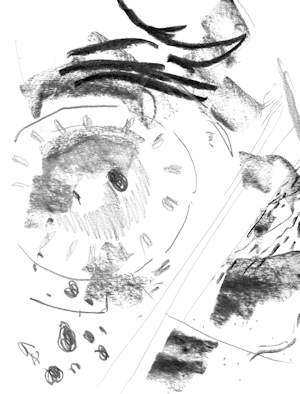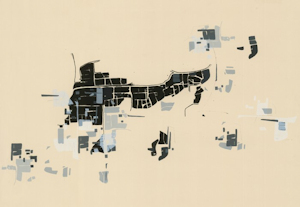
Enclosures at Thwing, Graphite, 2008
While processing the geophysical survey we carried out at Thwing between 2004 and 2007 (Ferraby et al. forthcoming), I became fascinated with the tones and textures revealed by the features cut in the chalk. The enclosure ditches were deeply etched into the landscape, while only fine, light traces of other features remained. The graphite is a medium that allows for these precise marks, as well as clear switches in the strength of mark (Figure 5). The process was one of learning the site, in all its forms and details.

Thwing, Screenprint, 2009
A screenprint is formed of layers of ink, each created by a separate image (or 'positive') that is exposed to UV light on a screen. To build the layers of ink on the paper was for me the opposite of the way we, as archaeologists, peel them back on the ground, or phase them in our analysis of geophysics and aerial photography. My own use of texture, colour, opacity and layering on the paper created a mix of interpretation and abstraction (Figure 6). It is a process that allowed me to think about the landscape in a different way, changing the way I thought about images and my interpretation of them. The use of screenprinting as a tool gave me another lens through which to think through archaeological sites and data.

Bagni di Tivoli, wax crayon and watercolour, 2009
A field outside Rome by a thermal spring was once the site of a villa. Bagni de Tivoli was a site we surveyed in 2007 (Ferraby and Pett 2007), an expanse of edgeland now used for more mixed and dubious activities on the rural-urban fringe. For days the field yielded silence, grid after grid of quiet magnetics. Until the last day, when, in the corner, the regimented clarity of a Roman villa emerged, surrounded by the noise of rubble. The drawing engaged with the idea of discovery: white wax crayon was used to show negative magnetic anomalies. They were virtually invisible. It was only when the black watercolour was added that they emerged from the page (Figure 7).

On the Wolds, charcoal. Graphite, conte crayon and pencil, 2010
One of the pleasures of drawing from geophysical images is picking out the array of lines, anomalies, and changes in contrast and tone. In doing this, it is possible to play with the creation of marks that echo the subtle changes beneath the surface. There is the space to play with a range of media: a soft charcoal to give a rough-edged, deep-dark line; a graphite block for a homogeneous wave grey-hued shadow; a conte crayon for the regular but airy black of an interrupted surface; a 2B pencil for some precise and sharp lines, dots and anomalous forms (Figure 8). Thinking through the marks, I begin to reflect on the character and form of that archaeological feature. As my hand works across the surface of the paper, my mind has slipped beneath the surface of the Earth to wonder upon the relationship of stone and silt, of things built and things left void. The process of making marks is in itself a process of excavation.

Field boundary, screenprint, 2010
I used screenprinting here to explore the idea that during geophysical and aerial surveys small shapes and pixels are slowly mapped to create our impression of landscape. One monochromatic shape is added upon another in a slow, flat rendition of an area. Any sense of scale is lost. The eye searches for meaning and pattern in the lines and clusters of tones (Figure 9).

Internet Archaeology is an open access journal based in the Department of Archaeology, University of York. Except where otherwise noted, content from this work may be used under the terms of the Creative Commons Attribution 3.0 (CC BY) Unported licence, which permits unrestricted use, distribution, and reproduction in any medium, provided that attribution to the author(s), the title of the work, the Internet Archaeology journal and the relevant URL/DOI are given.
Terms and Conditions | Legal Statements | Privacy Policy | Cookies Policy | Citing Internet Archaeology
Internet Archaeology content is preserved for the long term with the Archaeology Data Service. Help sustain and support open access publication by donating to our Open Access Archaeology Fund.